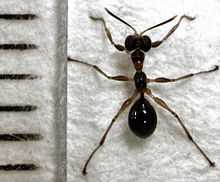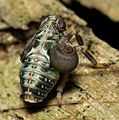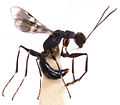Dryinidae
| Dryinidae | |
|---|---|
 | |
| Gonatopus alpinus female | |
| Scientific classification | |
| Kingdom: | Animalia |
| Phylum: | Arthropoda |
| Class: | Insecta |
| Order: | Hymenoptera |
| Suborder: | Apocrita |
| Superfamily: | Chrysidoidea |
| Family: | Dryinidae |
| Subfamilies | |
|
Anteoninae | |
Dryinidae is a family of wasps. They are solitary. The larvae are parasitoids on other insects. There are approximately 1400 species in this family.[1]
The adult wasp is up to 11 millimeters long,[1] but can be as small as 1.5 millimeters.[2] Species are usually sexually dimorphic; males have wings while females are often wingless and resemble worker ants. Females may also have front legs modified with a pinching apparatus which they use to restrain the hosts for their larvae during oviposition. The body of the adult wasp has a 'waist' where it is constricted in the middle. The rear legs have spurs which may be used for grooming. The antennae have 10 segments. The ovipositor is retractable and not visible when retracted. The larvae are legless or have only vestigial legs.[2]
Dryinid wasp larvae are parasitoids on various species of hemipterans, lepidopterans, and beetles.[2] The female injects an egg into the host insect with her ovipositor. The larva feeds on the internal structures of the host, and as it grows larger it begins to protrude from the body. It develops a hardened sac around its body for protection. The host is eventually killed and the larva leaves the dead body and spins a cocoon.[1]
Gallery
-

Issus coleoptratus nymph with dryinid larva under right wing
References
- ↑ 1.0 1.1 1.2 Dryinidae. Identification of Principal Groups of Insects. Discoveries in Natural History & Exploration. UC Riverside.
- ↑ 2.0 2.1 2.2 Watson, L. and M. J. Dallwitz. Dryinidae. British Insects: The Families of Hymenoptera. 2012 Version.
External links
| Wikispecies has information related to: Dryinidae |
| ||||||||||||||||||||||||||||||||||||||||||||||||||||||||||||||||||||||||||||||||||||||||||||||||||||||||||

.jpg)
